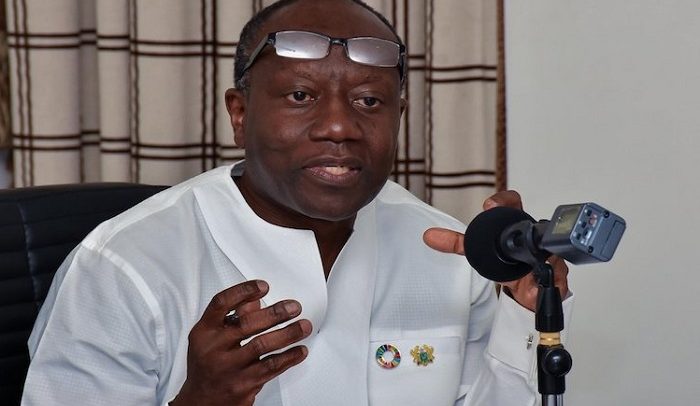Ken Ofori-Atta
THE MINISTER of Finance, Ken Ofori-Atta, says the country’s headline inflation has remained in single digit since June 2018 to date, and more recently steadied around the medium-term target of 8.0 per cent.
In August 2019, the Ghana Statistical Service rebased the Consumer Price Index (CPI) to reflect the changing consumption pattern of consumers as contained in the Ghana Living Standards Survey (GLSS 7) 2017, and reset the base year to 2018.
According to Mr. Ofori-Atta, following this, a new measure of headline inflation was estimated at 7.8 per cent for August 2019, within the lower band of the medium-term inflation target band of 8±2 per cent.
Presenting the government’s 2020 Mid-Year Budget Review to Parliament on Thursday, the Finance Minister indicated that food inflation was reported at 8.2 per cent and non-food inflation was at 7.4 per cent.
“Inflation subsequently increased to 8.2 per cent in November 2019 from 7.7 per cent in October due to an upward adjustment in some administrative prices, but declined to 7.9 per cent at end-December 2019, supported by lower food prices,” he disclosed.
External Sector Performance in 2019
Mr. Ofori-Atta intimated that the external sector performance remained relatively strong in 2019, supported by a larger trade surplus, a modest current account deficit and improvements in the capital and financial account net inflows, mainly due to the Eurobond issuance and an increase in foreign direct investment (FDI).
“The current account recorded a deficit of US$1.86 billion (2.8% of GDP) in 2019 compared to a deficit of US$2.04 billion (3.1% of GDP) in 2018.”
“The narrowing of the deficit was as a result of sustained gains in the trade balance and current transfers (largely from private inward remittances) which moderated the net outflows in the services and income accounts.”
“The trade balance continued to improve; underpinned by strong performance in some of the major export commodities, especially gold and cocoa beans and products (which benefited from both volume and price developments), resulting in a trade surplus of US$2.26 billion (3.4 per cent of GDP) at the end of December 2019.”
He said this was an improvement on the US$1.81 billion (2.8 per cent of GDP) trade surplus recorded in the same period of 2018, pointing out that the services, income and transfers accounts recorded a deficit of US$4.12 billion, a deterioration of US$0.27 billion from the preceding year.
The persistent deficits on the services and income accounts continued and recorded net outflows of US$7.53 billion in 2019 compared to US$6.44 billion in 2018. However, the current transfers account balance, mainly driven by private inward remittances improved to US$3.40 billion in 2019, from US$2.58 billion in 2018, he told Parliament.
Interest rates
The Finance Minister disclosed that the Monetary Policy Rate (MPR) was cut by 100 basis points in 2019 as inflation declined and inflation expectations eased and added that in line with this, the interbank weighted average rate (IWAR) decreased to 15.2 per cent in December 2019 from 16.1 per cent in December 2018.
“The reduction in the IWAR was as a result of a reduction in BOG’s participation on the overnight market to encourage trading among banks. Similarly, the average lending rate marginally declined to 23.6 per cent in December 2019, from 23.9 per cent in December 2018.”
The yields on Treasury Bills, however, increased marginally in 2019, he stated and continued that the 91-day Treasury bill rate inched up to 14.7 per cent in December 2019 compared with 14.6 per cent a year earlier.
According to him, interest rates on the 182-day instrument also moved up to 15.2 per cent, from 15.0 per cent over the same period. In contrast, rates on the secondary bond market remained broadly stable or declined. Yield on the seven-year bond declined to 16.3 per cent in December 2019 from 18.8 per cent in December 2018.
He, however, said the yield on the 15-year bond saw a slight uptick to 20 per cent in December 2019 from 19.5 per cent in December 2018; while yield on the 10-year bond, also edged up slightly to 19.8 per cent in 2019 from 19.5 per cent in 2018.
By Ernest Kofi Adu, Parliament House

